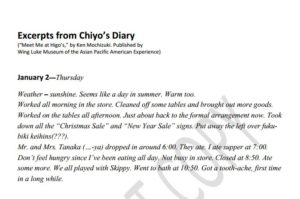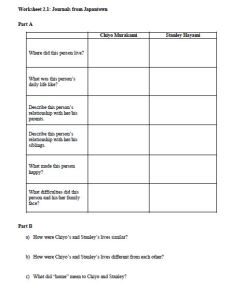##Note: The Wing Luke is in the process of getting permission to use Stanley Hiyami’s diaries as part of this lesson. The lesson still works well to explore through Chiyo Murakami’s diary entries what life was like in Seattle’s Nihonmachi. When secured, this lesson will be updated.
The Thought: The ability to empathize with Japanese-American families’ and individuals’ experiences greatly adds to the student’s analysis of historical events and their impact on American society.
Description: By examining similarities and differences between their own lives and those of two young adults living in Japantowns in 1936 Seattle and Los Angeles, students will create personal connections and develop empathy and respect for people from other cultural groups and historical periods.
Student Objectives:
1. Explain the definition of “community” and elements needed to create and maintain one.
2. Identify similarities and differences between themselves and young Japanese-Americans in 1936.
3. Express their reflections on community life in 1936 Japantown through original poetry.
Timeframe: This lesson is designed for 1 45-minute class periods. If desired, students can be assigned homework to read Chiyo’s diary entries and at least one of the Murakami family letters before the class period. If time permits, students can also read through Stanley Hayami’s pre-war entries in his diary. Chiyo was born and raised in Seattle and Stanley in Los Angeles. These two very different diaries give students insight into the life of these two different communities, with their similarities and differences.
Materials: Worksheet 2.1, pen and paper, whiteboard or wall, markers
Readings: Excerpts from Chiyo Murakami’s diary, Murakami Family Letters, Stanley Hiyami’s diary
Vocabulary:
citizen
diary
haiku
Issei
loyalty
Nihonmachi
Nisei
sanitarium
tanka
tuberculosis
Additional Resources: “Talking Walls” by A. Vincent Ciardiello, Meet Me at Higo: An Enduring Story of a Japanese-American Family by Ken Mochizuki, Divided Destiny: A History of Japanese Americans in Seattle by David A. Takami.
Teacher Preparation: Read through Chiyo Murakami’s diary entries. Read part 1 of Divided Destiny: A History of Japanese Americans in Seattle (through page 38) to learn more about Japanese-American communities pre-1941.
Activity 1: Journals
1. Write the word “community” on the board. Ask students to freewrite for five minutes on the topic of community and what it means to them.
2. Divide students into groups of three to four. Have them work together to answer the following questions, referring to their freewriting if desired.
a) What is your definition of “community”?
b) What role do you play in your community?
c) What items do you own that make you feel at home?
d) How would your community be different if you were forced to live somewhere else?
e) If you were writing about your community, what would you want someone outside of your community to know?
Have groups briefly share their answers with the class.
3. Explain that Japanese immigrants formed thriving communities in many American cities, despite being banned from owning land or becoming citizens. The areas where many Japanese lived became known as “Nihonmachi” or “Japantown”. Tell students they will be learning about life in Nihonmachi by reading the diary entries of Chiyo Murakami, whose family owned a variety store in Seattle. Through her diary, we are able to peek into what life was like for this young American before World War II. Her story, while tragic, shows how her experiences in one year put her and her family directly into Seattle and World History.
4. Divide the class into two equal groups. Give copies of Chiyo’s diary to students in group A and copies of Stanley’s diary to students in group B. Have students read their assigned diary and fill out Worksheet 2.1, Part A for either Chiyo or Stanley.
5. Ask students to find a partner from the opposite group and share their answers. As they listen to their partner’s answers, each student should fill in the rest of Part A of the worksheet. After they have completed the chart, ask students to discuss and answer the questions in Part B.
6. Ask students how Chiyo’s and Stanley’s lives are different from their own. Write their answers on the board. Then ask what similarities they see between Chiyo’s and Stanley’s lives and their own, and write those answers on the board.
Class Period 2
- Ask students what they know about haiku poems. Explain that haiku are a traditional Japanese poetry form, consisting of three lines following the syllable pattern 5-5-7. Haiku are traditionally written about nature, contain vivid imagery, and compare or contrast two things. Explain that haiku writing was very popular among Japanese-Americans before World War II, and write examples of haiku on the board (from the handout on Japanese-American haiku.) For further information on haiku refer to “Haiku for People” at http://www.toyomasu.com/haiku/, and “Pre-War Japanese American Haiku” at http://www.english.illinois.edu/maps/poets/g_l/haiku/about.htm.
- Have each student write their poem on a large piece of paper and put it on the wall. Once all students have finished, ask students to walk around and read the poems. Remind them to keep quiet as they read.
- After reading the poems, have students return to their seats. Ask them how they felt while reading their classmate’s poems. Was there a poem they felt especially connected to? Why? Is there anything you’d like to say to Chiyo or Stanley if you met them?
- Have each student write a haiku or tanka poem from the point of view of either Chiyo or Stanley, using the information from the diaries and Worksheet 1. Suggested topics include parents, siblings, pets, friends, fears, hopes, dislikes and/or community life. OPTIONAL: For older students, they could write tanka (poems of 5-7-5-7-7 syllables) instead of haiku. Refer to the handout on tanka poetry for further information. (Note: the museum has had great success working with 4-5th grade students on tanka poetry. We encourage teachers to determine whether this form of poetry would work for their classrooms.)
- Have students refer back to their definition of “community” from the beginning of the lesson. Ask them if they would make any changes or additions to their definition after reading and reflecting on the diaries and poems.
- Ask students how they think Japanese communities in the U.S. changed over time, especially after the start of World War II. This will the subject of the next lesson.

